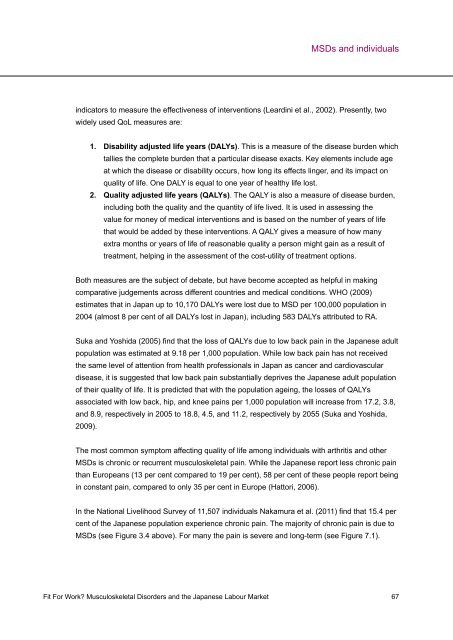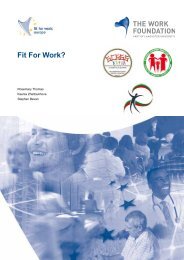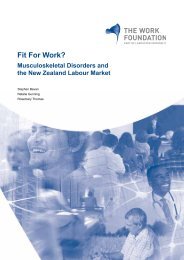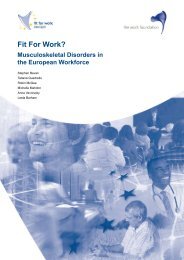English version - Fit for Work Europe
English version - Fit for Work Europe
English version - Fit for Work Europe
Create successful ePaper yourself
Turn your PDF publications into a flip-book with our unique Google optimized e-Paper software.
MSDs and individuals<br />
indicators to measure the effectiveness of interventions (Leardini et al., 2002). Presently, two<br />
widely used QoL measures are:<br />
1. Disability adjusted life years (DALYs). This is a measure of the disease burden which<br />
tallies the complete burden that a particular disease exacts. Key elements include age<br />
at which the disease or disability occurs, how long its effects linger, and its impact on<br />
quality of life. One DALY is equal to one year of healthy life lost.<br />
2. Quality adjusted life years (QALYs). The QALY is also a measure of disease burden,<br />
including both the quality and the quantity of life lived. It is used in assessing the<br />
value <strong>for</strong> money of medical interventions and is based on the number of years of life<br />
that would be added by these interventions. A QALY gives a measure of how many<br />
extra months or years of life of reasonable quality a person might gain as a result of<br />
treatment, helping in the assessment of the cost-utility of treatment options.<br />
Both measures are the subject of debate, but have become accepted as helpful in making<br />
comparative judgements across different countries and medical conditions. WHO (2009)<br />
estimates that in Japan up to 10,170 DALYs were lost due to MSD per 100,000 population in<br />
2004 (almost 8 per cent of all DALYs lost in Japan), including 583 DALYs attributed to RA.<br />
Suka and Yoshida (2005) find that the loss of QALYs due to low back pain in the Japanese adult<br />
population was estimated at 9.18 per 1,000 population. While low back pain has not received<br />
the same level of attention from health professionals in Japan as cancer and cardiovascular<br />
disease, it is suggested that low back pain substantially deprives the Japanese adult population<br />
of their quality of life. It is predicted that with the population ageing, the losses of QALYs<br />
associated with low back, hip, and knee pains per 1,000 population will increase from 17.2, 3.8,<br />
and 8.9, respectively in 2005 to 18.8, 4.5, and 11.2, respectively by 2055 (Suka and Yoshida,<br />
2009).<br />
The most common symptom affecting quality of life among individuals with arthritis and other<br />
MSDs is chronic or recurrent musculoskeletal pain. While the Japanese report less chronic pain<br />
than <strong>Europe</strong>ans (13 per cent compared to 19 per cent), 58 per cent of these people report being<br />
in constant pain, compared to only 35 per cent in <strong>Europe</strong> (Hattori, 2006).<br />
In the National Livelihood Survey of 11,507 individuals Nakamura et al. (2011) find that 15.4 per<br />
cent of the Japanese population experience chronic pain. The majority of chronic pain is due to<br />
MSDs (see Figure 3.4 above). For many the pain is severe and long-term (see Figure 7.1).<br />
<strong>Fit</strong> For <strong>Work</strong>? Musculoskeletal Disorders and the Japanese Labour Market 67







